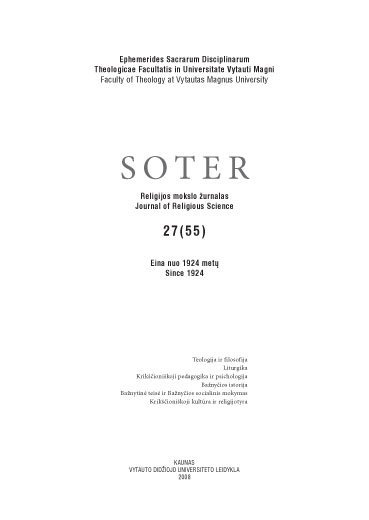Mokymasis mirti kaip gyvenimo esmė ir tikslas
LEARNING TO DIE AS THE ESSENCE AND THE OBJECTIVE OF LIFE
Author(s): Agnė BudriūnaitėSubject(s): Christian Theology and Religion
Published by: Vytauto Didžiojo Universitetas
Keywords: mokymasis mirti; egzistencinė filosofija; prasmė; tikslas; learning to die; existential philosophy; purpose; meaning.
Summary/Abstract: This article investigates the problem of learning to die. Learning to die is the objective of any kind of philosophy and every human life process according to ancient tradition. The signification of this idea depends on the meaning of “learning” and the meaning of “die”. The existential dimension is chosen from a very wide range of possible outlooks. Two opposing views are the basis of this investigation. Learning to die is an impossible action, the French philosopher and psychologist Vladimir Jankelevitch (1903-1985) affirms. Death is a simple undivided act according to Jankelevitch. There is nothing to learn from it because it is impossible to repeat death, to improve one‘s skills or to have an experience of it. A very different view is that of the Austrian philosopher and psychologist Benedictine monk David Steindl-Rast (1926- ). He thinks that learning to die is essential to a human being as well as learning to live authentically. V. Jankelevitch and D. Steindl-Rast represent two opposite opinions at first sight. The aim of this article is to settle the differences and to show in what way learning to die is possible and can be the essence and the objective of life. Wide-ranging professional concerns are inherent to these authors and make them perfect for the aim of this article. The interdisciplinary research for this article presupposes the meeting (but not the amalgamation) of philosophy and psychology. Of course, some concepts lose their strict definitions and specificity. This is the problem and the negative side of the interdisciplinary research. The positive side is the versatility of the study of the problem and its closeness to the contemporary mind. This is more important when we talk about the existential ideas that exceed the framework of one sphere of life. The overarching concepts are “purpose” and “meaning” used neither in a clinical nor in a scholastic or an analytic sense. The existential sense of the concepts is evident in talking about the concrete aspects of death. The main distinction of “purpose” and “meaning” is defined by D. Steindl-Rast as follows: all purposes and projects of life come to an end with death, but meaning can still persist. Several aspects of consciousness of death are examined. The perception of the fact of death is usually a matter of statistics. There is nothing to learn in such a onetime fact of the past. The fact of death may be considered as the purpose of biological life but usually is lacking in meaning. The dead person cannot convey the meaning afterwards. Other people keep thinking about good things that will never happen because of death. Another aspect of death could be found in the case of considering somebody “dead” - of forgetting or ignoring somebody’s existence. very little possibility for learning appears in this aspect of death. Learning to die in this situation would be learning to find and to keep one’s own individuality despite the opinion of others. Learning to die would be dis
Journal: SOTER: religijos mokslo žurnalas
- Issue Year: 55/2008
- Issue No: 27
- Page Range: 7-19
- Page Count: 13
- Language: Lithuanian

